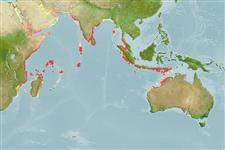>
Ovalentaria/misc (Various families in series Ovalentaria) >
Pomacentridae (Damselfishes) > Pomacentrinae
Etymology: Neopomacentrus: Greek, neos = new + Greek,poma = cover, operculum + Greek,kentron = sting (Ref. 45335); sororius: Name from Latin meaning sisterly, referring to its close relationship to N. azysron..
More on authors: Randall & Allen.
Environment: milieu / climate zone / depth range / distribution range
Écologie
marin récifal; profondeur 2 - 14 m (Ref. 57550). Tropical
Indian Ocean: Kenya to Thailand, south to Indonesia.
Taille / Poids / Âge
Maturity: Lm ? range ? - ? cm
Max length : 6.4 cm SL mâle / non sexé; (Ref. 57550); 5.5 cm SL (female)
Description synthétique
Morphologie | Morphométrie
Épines dorsales (Total): 13; Rayons mous dorsaux (Total): 11-12; Épines anales 2; Rayons mous anaux: 11 - 12; Vertèbres: 26. Diagnosis: Ventral edge of the suborbital scaled over. Dorsal and anal soft rays usually 11; pectoral usually 18. Tubed lateral line scales modally 17; gill rakers 20-23, usually 21-22. Body depth 2.4-2.95 in SL. Caudal fin and posterior part of dorsal fin yellow; anal fin mainly yellow without small blue spots; pectoral fin axil with a black spot, continuing as a prominent wedge shaped spot above the fin base; a black spot covering all but ventral part of pectoral fin base. There is a black spot as large or larger than pupil over first lateral line scale (Ref. 57550).
Collected and observed on coral reefs or rocky bottom (Ref. 57550). Life history characteristics for the family specify that this group is oviparous, with distinct pairing during breeding (Ref. 205). Eggs are demersal and adhere to the substrate (Ref. 205). Males guard and aerate the eggs (Ref. 205).
Life cycle and mating behavior
Maturité | Reproduction | Frai | Œufs | Fécondité | Larves
Life history characteristics for the family specify that this group is oviparous, with distinct pairing during breeding (Ref. 205). Eggs are demersal and adhere to the substrate (Ref. 205). Males guard and aerate the eggs (Ref. 205).
Randall, J.E. and G.R. Allen, 2005. Neopomacentrus sororius, a new species of damselfish from the Indian Ocean, with descriptinof a neotype for its sister species, N. azyron (Bleeker). aqua, J. Ichthyol. Aquat. Biol. 10(2):72-80. (Ref. 57550)
Statut dans la liste rouge de l'IUCN (Ref. 130435)
Menace pour l'homme
Harmless
Utilisations par l'homme
Plus d'informations
PaysZones FAOÉcosystèmesOccurrencesIntroductionsStocksÉcologieRégime alimentaireÉléments du régime alimentaireConsommation alimentaireRation
Taille/ÂgeCroissanceLongueur-poidsLongueur-longueurFréquences de longueursMorphométrieMorphologieLarvesDynamique des populations larvairesRecrutementAbondanceBRUVS
RéférencesAquacultureProfil d'aquacultureSouchesGénétiqueElectrophoresesHéritabilitéPathologiesTraitementNutrientsMass conversion
CollaborateursImagesStamps, Coins Misc.SonsCiguateraVitesseType de nageSurface branchialeOtolithesCerveauxVision
Outils
Articles particuliers
Télécharger en XML
Sources Internet
Estimates based on models
Preferred temperature (Ref.
123201): 26.9 - 29.3, mean 28.4 °C (based on 908 cells).
Phylogenetic diversity index (Ref.
82804): PD
50 = 0.5000 [Uniqueness, from 0.5 = low to 2.0 = high].
Bayesian length-weight: a=0.02344 (0.01149 - 0.04783), b=2.99 (2.82 - 3.16), in cm total length, based on LWR estimates for this (Sub)family-body shape (Ref.
93245).
Niveau trophique (Ref.
69278): 3.4 ±0.4 se; based on size and trophs of closest relatives
Résilience (Ref.
120179): Haut, temps minimum de doublement de population inférieur à 15 mois (Preliminary K or Fecundity.).
Fishing Vulnerability (Ref.
59153): Low vulnerability (10 of 100).
